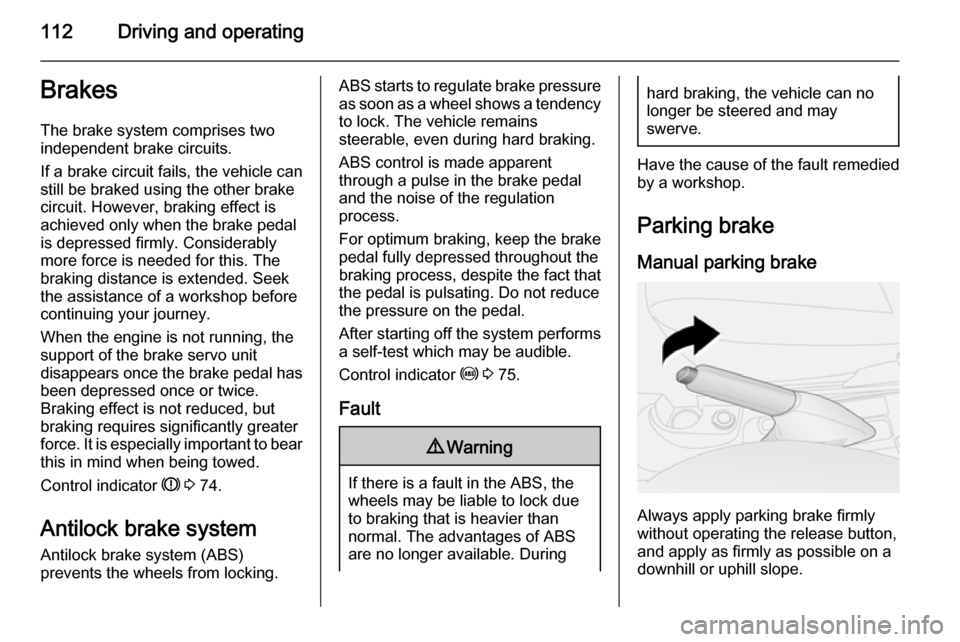ABS VAUXHALL COMBO 2014 Owner's Manual
[x] Cancel search | Manufacturer: VAUXHALL, Model Year: 2014, Model line: COMBO, Model: VAUXHALL COMBO 2014Pages: 187, PDF Size: 4.15 MB
Page 77 of 187

Instruments and controls759Warning
Stop. Do not continue your
journey. Consult a workshop.
Illuminates if the brake vacuum servo
fails; the brake pedal becomes stiff
when pressed. The brake system
remains operational however,
assistance will be reduced. The
steering may also require
considerably more effort when
turning.
Illuminates after the ignition is
switched on if the parking brake is
applied 3 112.
Brake pad wear F illuminates yellow.
The front brake pads are worn, seek
the assistance of a workshop
immediately.
Antilock brake system
(ABS)
u illuminates yellow.
Illuminates for a few seconds after the
ignition is switched on. The system is
ready for operation when the control
indicator extinguishes.
If the control indicator does not
extinguish after a few seconds, or if it illuminates while driving, there is a
fault in the ABS. The brake system
remains operational but without ABS
regulation.
Antilock brake system 3 112.
Upshift [ or Ò illuminates in the Driver
Information Centre 3 79 when
gearshifting is recommended to
improve fuel economy.
Hill start assist
Z illuminates yellow.
Illuminates when the ignition is
switched on and extinguishes shortly
after the engine starts.
If the control indicator does not
extinguish after a few seconds, or if it illuminates while driving, there is afault in the Hill start assist. Seek the
assistance of a workshop to have the
fault remedied.
The Electronic Stability Program
(ESP) control indicator x may also
illuminate 3 76 in conjunction with
Z .
Depending on model variant, 9 will
illuminate as an alternative if control
indicator Z is not present. A warning
message may also be displayed in
the Driver Information Centre 3 79.
Generic warning 9 3 73.
Hill start assist 3 113.
Ultrasonic parking assist r illuminates yellow.
Fault in system
or
Fault due to sensors that are dirty or
covered by ice or snow
or
Page 114 of 187

112Driving and operatingBrakes
The brake system comprises two
independent brake circuits.
If a brake circuit fails, the vehicle can
still be braked using the other brake
circuit. However, braking effect is
achieved only when the brake pedal
is depressed firmly. Considerably
more force is needed for this. The
braking distance is extended. Seek the assistance of a workshop before
continuing your journey.
When the engine is not running, the
support of the brake servo unit
disappears once the brake pedal has been depressed once or twice.
Braking effect is not reduced, but
braking requires significantly greater
force. It is especially important to bear this in mind when being towed.
Control indicator R 3 74.
Antilock brake system Antilock brake system (ABS)
prevents the wheels from locking.ABS starts to regulate brake pressure as soon as a wheel shows a tendency
to lock. The vehicle remains
steerable, even during hard braking.
ABS control is made apparent
through a pulse in the brake pedal
and the noise of the regulation
process.
For optimum braking, keep the brake
pedal fully depressed throughout the
braking process, despite the fact that
the pedal is pulsating. Do not reduce
the pressure on the pedal.
After starting off the system performs a self-test which may be audible.
Control indicator u 3 75.
Fault9 Warning
If there is a fault in the ABS, the
wheels may be liable to lock due
to braking that is heavier than
normal. The advantages of ABS are no longer available. During
hard braking, the vehicle can nolonger be steered and may
swerve.
Have the cause of the fault remedied
by a workshop.
Parking brake Manual parking brake
Always apply parking brake firmly
without operating the release button,
and apply as firmly as possible on a
downhill or uphill slope.
Page 157 of 187

Vehicle care155Appearance care
Exterior care
Locks The locks are lubricated at the factoryusing a high quality lock cylinder
grease. Use de-icing agent only when
absolutely necessary, as this has a
degreasing effect and impairs lock function. After using de-icing agent,
have the locks regreased by a
workshop.
Washing The paintwork of your vehicle is
exposed to environmental influences.
Wash and wax your vehicle regularly.
When using automatic vehicle
washes, select a programme that
includes waxing.
Bird droppings, dead insects, resin,
pollen and the like should be cleaned off immediately, as they contain
aggressive constituents which can
cause paint damage.If using a vehicle wash, comply with
the vehicle wash manufacturer's
instructions. The windscreen wiper
and rear window wiper must be
switched off. Remove antenna and
external accessories such as roof
racks etc.
If you wash your vehicle by hand,
make sure that the insides of the
wheel housings are also thoroughly
rinsed out.
Clean edges and folds on opened
doors and the bonnet as well as the
areas they cover.Caution
Always use a cleaning agent with
a pH value of 4 to 9.
Do not use cleaning agents on hot surfaces.
Have the door hinges of all doors
greased by a workshop.
Do not clean the engine compartment with a steam-jet or high-pressure jet
cleaner.
Thoroughly rinse and leather-off the vehicle. Rinse leather frequently. Use
separate leathers for painted and
glass surfaces: remnants of wax on
the windows will impair vision.
Exterior lights
Headlight and other light covers are
made of plastic. Do not use any
abrasive or caustic agents, do not use an ice scraper, and do not clean them
dry.
Polishing and waxing Wax the vehicle regularly (at the
latest when water no longer beads).
Otherwise, the paintwork will dry out.
Polishing is necessary only if the paint
has become dull or if solid deposits
have become attached to it.
Paintwork polish with silicone forms a
protective film, making waxing
unnecessary.
Plastic body parts must not be treated with wax or polishing agents.
Page 162 of 187

160Service and maintenance
temperatures the factory filled coolant
provides frost protection down to
approx. -37°C. This concentration
should be maintained all year round.
The use of additional coolant
additives that intend to give additional
corrosion protection or seal against
minor leaks can cause function
problems. Liability for consequences
resulting from the use of additional
coolant additives will be rejected.
Brake and clutch fluid Only use high-performance DOT 4+brake fluid approved for the vehicle.
Consult a workshop.
Over time, brake fluid absorbs
moisture which will reduce braking
effectiveness. The brake fluid should therefore be replaced at the specified interval.
Brake fluid should be stored in a
sealed container to avoid water
absorption.
Ensure brake fluid does not become
contaminated.
Page 182 of 187

180IndexAAccessories and vehicle modifications .......................... 125
Adjustable air vents .....................99
Airbag activation ........................... 79
Airbag and belt tensioners ...........73
Airbag deactivation ..........45, 74, 79
Airbag system .............................. 41
Air conditioning regular operation ................................ 100
Air conditioning system ................ 96
Air intake .................................... 100
Air vents........................................ 99
Alert .............................................. 85
Antilock brake system ................ 112
Antilock brake system (ABS) .......75
Anti-Slip Regulator (ASR) ...........113
Anti-theft locking system .............. 26
Appearance care ........................155
Armrest ......................................... 35
Ashtrays ....................................... 67
ASR (Anti-Slip Regulator) ...........113
Audible warning chimes................ 85
Autoclose ...................................... 79
Automatic fuel cut-off ............85, 103
Automatic locking .........................79B
Battery ....................................... 130
Battery discharge protection ........94
Belts.............................................. 38 Bonnet ....................................... 127
Brake and clutch fluid .................159
Brake assist ............................... 113
Brake fluid .................................. 130
Brake pad wear ............................ 75
Brakes ............................... 112, 130
Brake system ............................... 74
Breakdown.................................. 153
Bulb replacement ....................... 132
C Capacities .................................. 173
Car Pass ...................................... 19
Catalytic converter .....................107
Central locking system ................21
Centre high-mounted brake light 135
Change engine oil .......................77
Changing tyre and wheel size ...144
Charging system .......................... 74
Child locks ................................... 22
Child restraint installation locations ................................... 49
Child restraints.............................. 47
Child restraint systems ................47